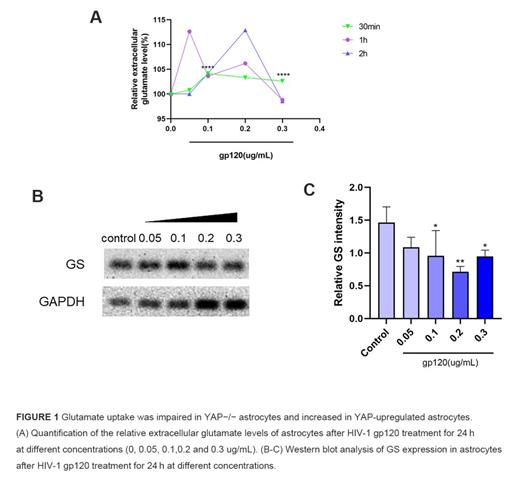Background:
As the most abundant subtype of glial cells, astrocytes have an important role in maintaining homeostasis in the central nervous system(CNS) by regulating neurotransmitters. Glutamate is an excitatory neurotransmitter released from neurons, while astrocytes take up glutamate and mediate the conversion to glutamine, which is known as the glutamate-glutamine cycle between neurons and astrocytes. Glutamine synthetase (GS) is found primarily in astrocytes and is a key player in the glutamate-glutamine cycle. GS synthesizes glutamine using glutamate and contributes to the maintenance of glutamate homeostasis between neurons and astrocytes by facilitating glutamate clearance. In addition, glutamate excitotoxicity is a key pathological factor in neurodegenerative pathologies such as HIV-1-associated neurocognitive disorder (HAND) and Alzheimer's disease. Although the importance of GS in the glutamate-glutamine cycle has been demonstrated, the relationship between gp120 in regulating astrocyte glutamate metabolism and GS activity is unclear.
Methods:
To evaluate the glutamate clearance capacity, glutamate uptake assay was undertaken by using the glutamate colorimetric assay kit. Astrocytes (u251) were incubated for 24 hours with different concentrations of full-length HIV-1 gp120 and medium in each dish was replaced with serum-free HBSS that containing 2 mM glutamate. After 10, 30, 60, or 120 min in the incubator, 200 μL culture supernatants of the astrocytes were collected and mixed with the corresponding reagents provided in the kit as required by the protocol, then 100 μL of the mixed solution were transferred to each well of the 96-well culture plates. The absorbance of the mixed solution was measured at 340 nm using a microplate reader. The glutamate content of each sample was calculated according to the formula provided in the instruction manual. The expressions of GS in astrocytes which were incubated for 24 hours with different concentrations of full-length HIV-1 gp120 were detected by Western blot. Student's t-tests and ANOVA were applied to determine statistical significance.
Results:
The glutamate uptake assay reflects whether the glutamate uptake capacity of astrocytes is impaired by assessing the extracellular glutamate content. First, changes in extracellular glutamate content were detected by treating astrocytes with different concentrations of HIV-1 gp120 for 24h. As expected, the extracellular glutamate content increased relative to the blank control, indicating that HIV-1 gp120 impaired the glutamate uptake ability of astrocytes. The optimal experimental point to test the glutamate uptake capacity was 30 min after the addition of serum-free HBSS that containing 2 mM glutamate by time-point experiments. In addition, the results of western blot showed that GS expression in astrocytes was significantly decreased by HIV-1 gp120 treatment. The GS expression levels and glutamate uptake assay results followed the same trend.
Conclusion:
In conclusion, this study explored the specific mechanisms of glutamatergic excitotoxicity in the brains of HAND patients. HIV-1 gp120 could impair the glutamate uptake capacity of astrocytes by diminishing GS expression. ( Acknowledgements: National Natural Science Foundation of China, No. 82172259 to H.C.; Corresponding author: Hong Cao, gzhcao@smu.edu.cn )
Disclosures
No relevant conflicts of interest to declare.


This feature is available to Subscribers Only
Sign In or Create an Account Close Modal